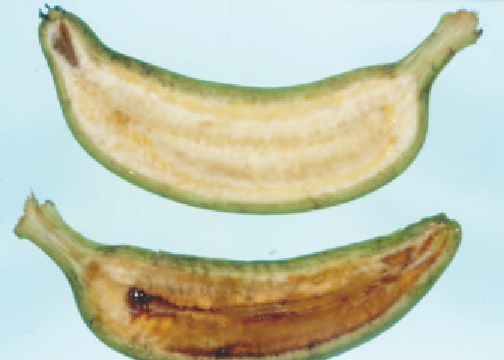Agriculture Reference
In-Depth Information
5
BANANA
(
Musa spp.
)
Banana is a member of the Musaceae family and its
primary centre of origin and diversity is in southern and
south-east Asia. Most edible bananas arose from two
species,
Musa acuminata
and
M. balbisiana
.
Bananas are perennial herbs that develop from
underground rhizomes. Until f lowering occurs, the entire
above-ground portion of the plant consists of leaves and
fused petiole bases forming a pseudostem. The true stem
and growing point rise from the rhizome and emerge
through the pseudostem at f flowering.
Bananas are propagated vegetatively, with either suckers or
rhizome pieces. Plantlets derived from meristem tip culture
are used widely in commercial production, because they
provide greater uniformity and are free from several
important pathogens.
Fig 5.1 Mokillo disease in banana shows the larger base and thinner
tip of the fruit. Internally, rust-coloured gumming can be seen.
Bananas are a major fruit crop, both in terms of trade and
importance as a staple food in many countries in Africa,
Asia and the Americas.
Source of infection and spread
The bacterium occurs naturally on f flowers and probably
transferred from f flower to f flower by pollinating insects.
In Australia, bananas are grown throughout the subtropical
and tropical coastal regions. The main production area is in
the wet tropics of north Queensland. Cavendish types are
the main varieties.
Importance
Mokillo disease is of minor importance. Infection is
infrequent and most fruit in the bunch are resistant.
Management
Management is not warranted and no specific management
measures are available.
BACTERIA
MOKILLO (GUMMING) DISEASE
(BACTERIAL FINGER-TIP ROT)
RHIZOME SOFT ROT
■
Cause
The bacterium
Pseudomonas
sp.
Cause
Bacteria of the soft-rotting
Erwinia
group, (
E. carotovora
subspp.,
E. chrysanthemi
).
Symptoms
Infected fruit are distorted and have a bulbous base but a
thinner tip. The fruit are less curved than usual and are out
of alignment with other fingers on the hand. Affected fruit
discolours internally, exhibited by rust-coloured gumming,
which often forms a brown ring when cut transversely.
Usually, only one finger per hand is infected.
Symptoms
Rotting in newly planted rhizomes causes poor emergence.
Survivors are yellow and stunted, and mature plants with
fruit may topple over, snapping at the base and revealing
rotting corms, often with noticeable stench. Pockets of
brown or yellow, water-soaked areas occur in the rhizome,













